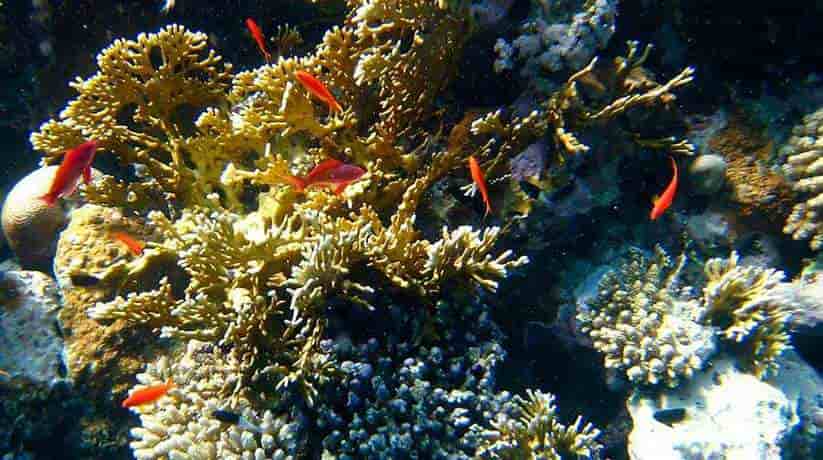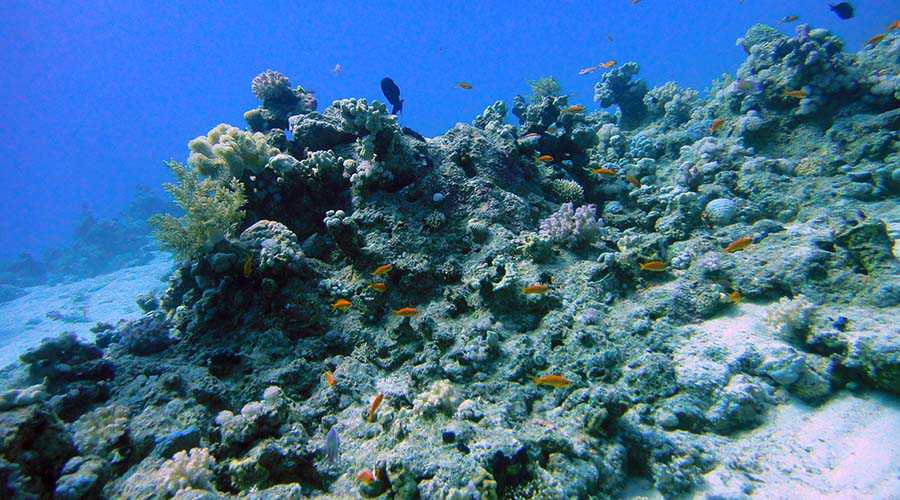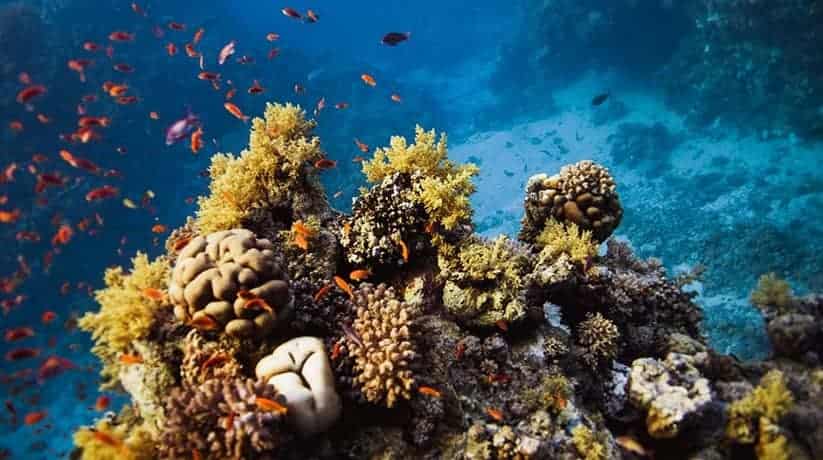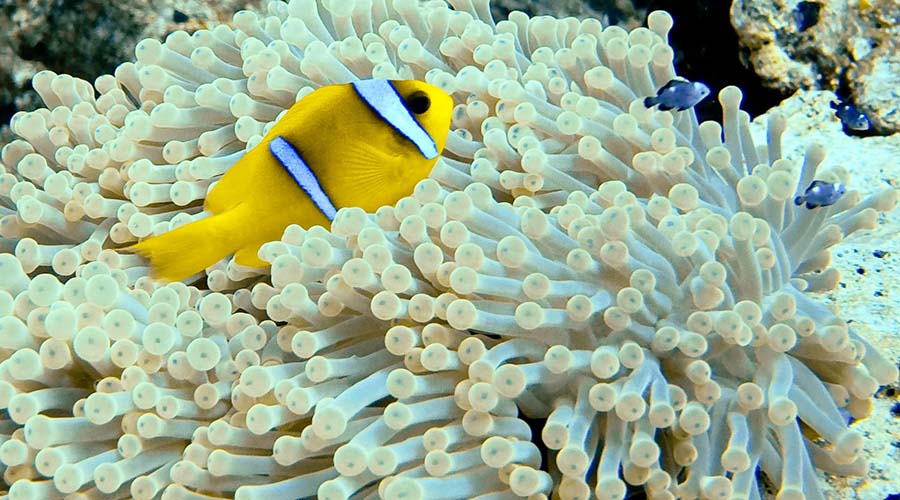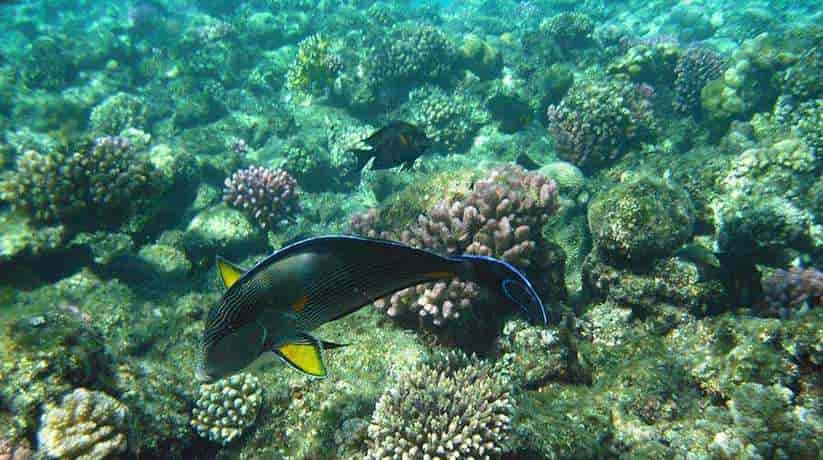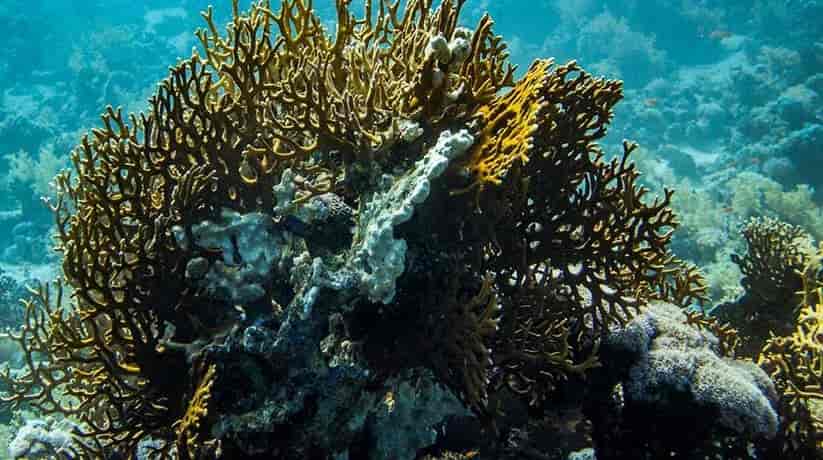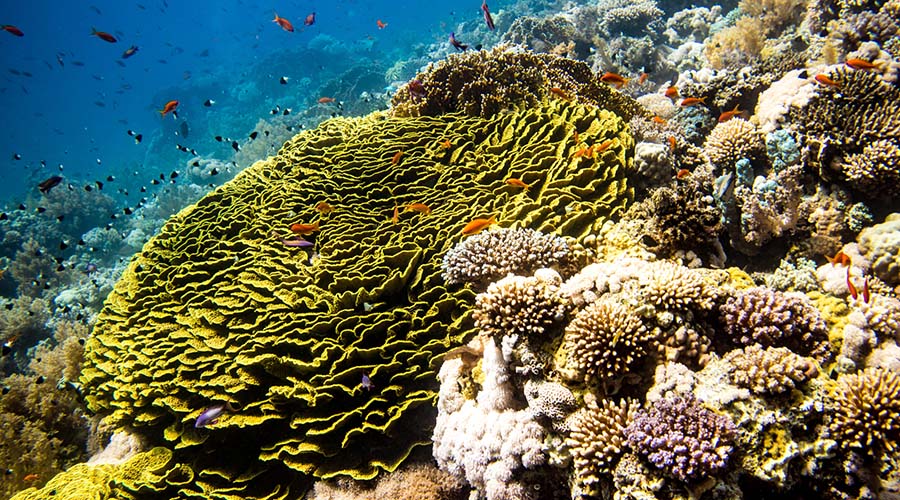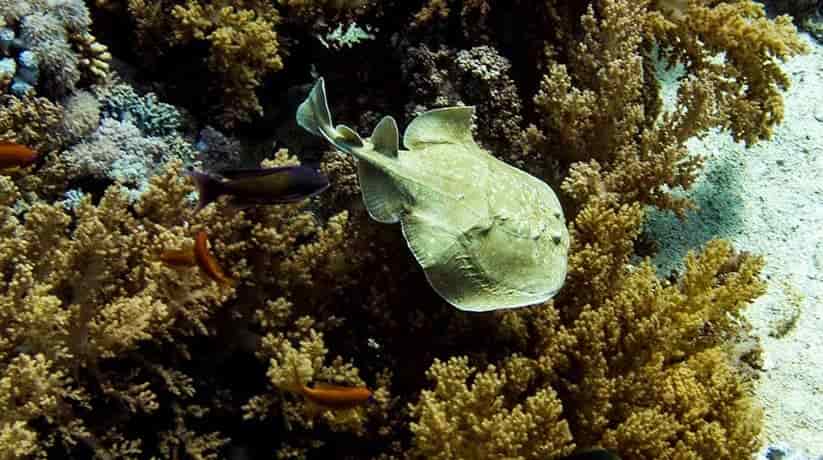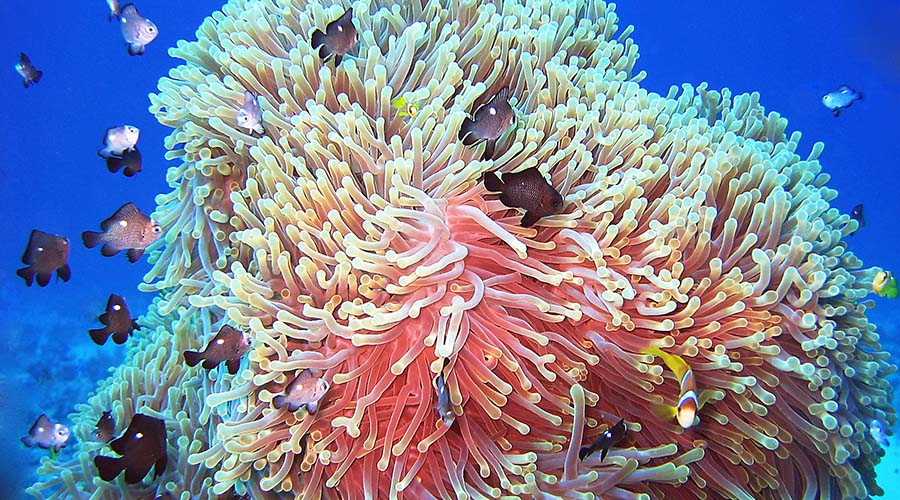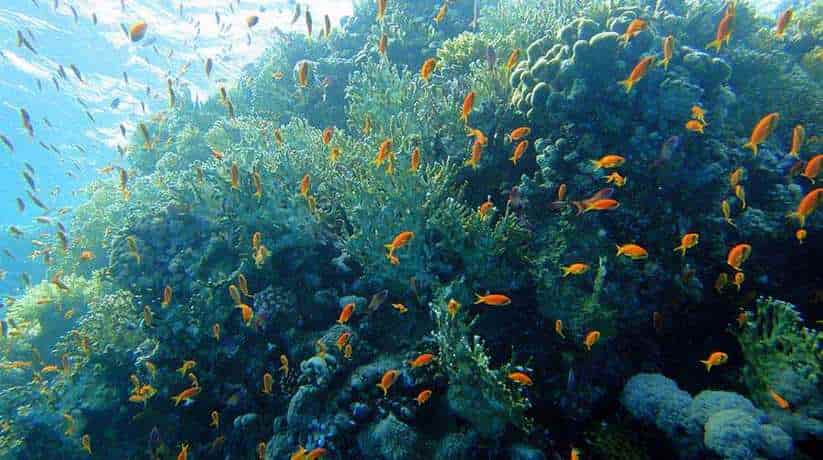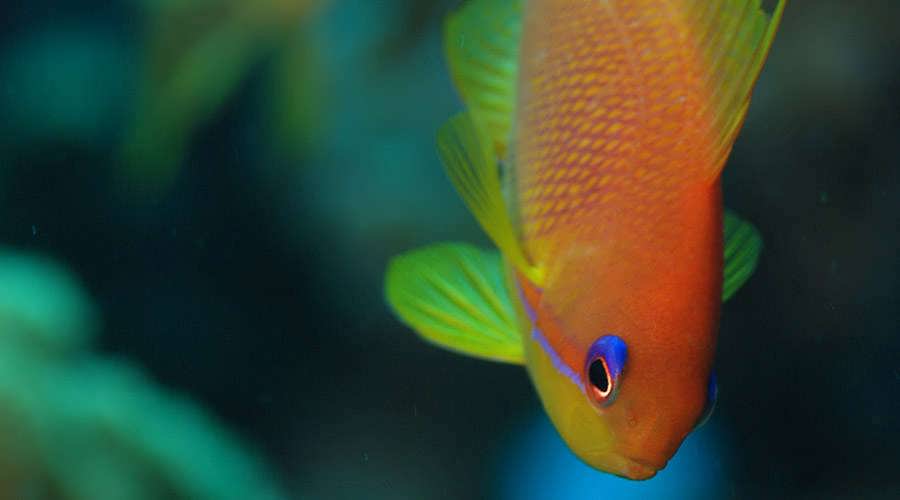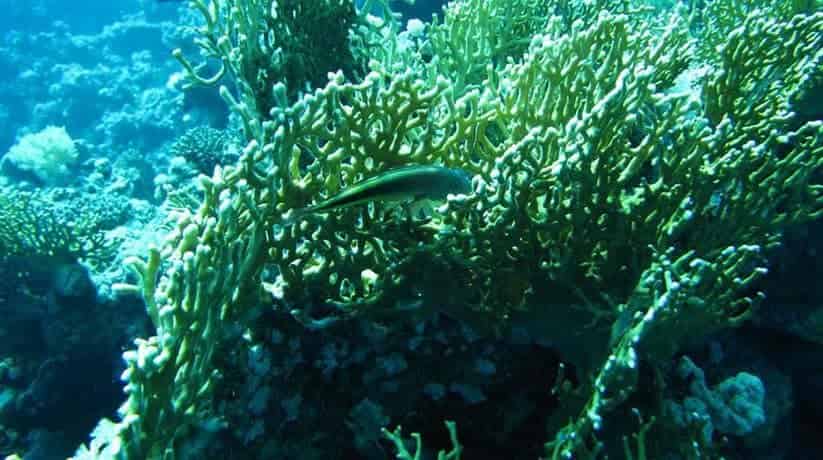Egypt Reef Diving information, tours, prices and online booking
Egypt Reef Diving feature many diving spots on the Egyptian Red Sea coast. “The Canyon”, Dahab’s most talked about site, and one of Sinai’s most interesting dives. In fact, it is close to the “Blue Hole”, an equally famous but more dangerous site. A few flipper strokes away from Assalah bay, you’ll reach a large rock head cloven. It is by a fissure descending to a wide entrance underwater. Passing through this entrance, you’ll find yourself surrounded by the crowded life and incredible beauty of the Canyon’s setting. After a 100 meter swim over a shallow reef from Dahab’s shore, you’ll reach a narrow canyon. You can swim out to a larger sandy area sloping down gradually. Past a somewhat vertical protuberance of the reef, you’ll discover the actual Dahab’s Eel Garden.
You’ll soon see the long eels popping their heads out of the sand. It is before vanishing back in as soon as you approach them. Hold your breath if you’re thinking of taking pictures of these amazing creatures. Don’t freak out at the sight of such a big number of eels. Due to its none easy to access location, Gabr El Bent is one of Dahab’s best preserved dive sites. You will need to hire a 4X4, a camel, or go on a diving boat trip to get there. Traditionally, divers have two ways of exploring this amazing reef. You would either choose to explore the right side of the reef. It also called the “dark side” which is a 60 meter drop-off with beautiful corals on the way. The left side is a lot more colorful, with amazing gorgonians.
More information about Egypt Reef Diving:
Regular visitors of the site include reef species of all sorts, including anthias and scorpion fish. The visitors also include parrot fish, stingrays, snappers and even sometimes turtles. Located a few meters off shore from the beach area in Dahab, the Lighthouse Reef. It is the easiest to access and most popular dive site on the agenda of Dahab’s dive schools and centers. It is also a great spot for Snorkeling. In fact, all kinds of dives are possible, including shallow dives over sandy areas for beginners. Pinnacle slaloms at more important depths for more experienced divers. Whichever the dive plan is, you’re bound to love it. It is for the variety of available coral formations to explore and the beautiful fish species to gaze at. These include turtles, dolphins, and big pelagic additionally to charming seahorses, crocodile fish, pipefish, and octopuses.
You’ll soon discover that the “Dolphin House” in El-Gouna proudly stands for its name. This diving site is in fact home to an incredible number of dolphins. You’ll probably get the chance to dive in the company of the whole resident pod of Bottlenose Dolphins. You might as well catch a glimpse of the other unique inhabitants of the reef. It includes turtles and hard coral gardens. Serib Kebir not only used as a site for check dives by most of the dive centers in El Quseir. It also withholds almost everything that a diver would look for in the Red Sea. As you start your descent from the shallow entry by the beach, you’ll dive down to 5 meters. It is into a bay where you’re most likely to find a school of Yellow Tailed Barracudas and an army of Squid on a hunting expedition.
Further information about the sites:
Most diving instructors will direct you from there to the north, in the direction of a hard coral garden where Blue Spotted Rays abound. The rays have become used to the divers. If you’re an underwater photography fan; this is the right occasion for you to make great shots. Join the never-ending ballet of Hatchet Sweeper fish that inhabit The Cathedral and a labyrinth of jaw. They drop canyons, tunnels and caverns, where amazing corals and beautiful nocturnal fish species such as the Big Eye Squirrel fish. In the close surroundings of the Cathedral, many divers already had the chance to meet with the resident small pod of Bottlenose Dolphins. An encounter that is usually consider as the “cherry on top” of this already amazing dive in El Quseir.
At only a few kilometers from Hurghada, lies the Big Giftun Island (Giftun Kebir). As you approach it by boat, you might think to yourself that it looks quite uninteresting in itself. In fact, it only consists of sand and rocks. But the waters surrounding the island hide some of Red Sea’s most beautiful diving sites. The southern and eastern parts of the submerged island covered with rare and well-preserved corals. On the eastern side of the narrowest part of the island, lies Erg Sabina. The main attraction of the site is a gigantic coral pinnacle, boasting amazing fire corals. Marine life abounds around the pinnacle. You should definitely bring down your camera. In fact, nudibranches, lobsters and angelfish are regular residents of the site.
More details about Egypt Reef Diving:
Located about 60 to 90 minutes from Hurghada, the reef of Abu-Nugar. In fact, it mainly dived for the incredible richness of its marine life. You’ll find a T-shaped reef at its north-western side and a shallow plateau dotted with numerous ergs (pinnacles) in its eastern part. These ergs are full of different types of fish and coral, including yellow and purple gorgonians, sea fans, table corals, and brain corals. The Western side of Sha-ab Abu Nugar has two smaller sub-reefs in it, they are Gota Abu Nugar and Sha’ab Iris. Also called “Shaker Island”, Shadwan Island is the largest atoll of the strait of Gubal. At the northeastern side of the island, you’ll find an amazing almost vertical coral wall dropping to more than 40 meters. The current is usually mild and runs from south to north. Divers go along with the current to explore the wall on a drift dive.
The reef is teeming with snappers and anthias, but bigger and far more interesting species are also regular visitors of the site. Divers have often encountered the presence white-tip reef sharks and grey reef sharks, hawksbill turtles, but most of all great pods of dolphins. Located a few km off Makadi Bay’s shore, and meaning “Father of Grass” in Arabic, this very shallow diving site – ideal for beginners – has been so named because of the abundance of sea grass in that particular area of the Red Sea. The reef is a combination of a slowly sloping sandy plateau and a fast dropping wall along which drift dives are usually performed from north to south, if the currents are strong enough. Boats are usually moored at the northwest lagoon, from where divers have to swim through a small canyon before reaching the sandy plateau.
Further information about the sites:
Beautiful corals are hidden under the sand; uncover their secrets delicately. Usually very small and interesting creatures nestled inside the bouquets. Puffer fish, morays, octopus, nudibranches, crabs and sea horses are regular visitors of Abu Hashish. While on holiday in Marsa Alam, think of taking a short boat trip to the shallow and sandy reef of Marsa Abu Dabbab, for an easy and relaxing dive, even if you’re still a beginner. This diving site is used as an overnight stop by most of the live boards cruising the Red Sea in that region. While diving in the Marsa Abu Dabbab site, you might get the chance of meeting dolphins, as well as the famous dugong “sea cows”, turtles and spotted rays. Straight off the beach at the Hilton Hotel in Nuweiba, you’ll find the famous Abu Lou Lou Reef, also referred to as the Hilton House Reef.
It known for the incredible richness of marine life including stonefish, turtles, and lionfish. A fact that led some divers to nickname it the “lionfish city.” The amazement you’ll experience at Abu Lou Lou is indescribable, since the amount of underwater species you’ll spot down there exceeds by far what you might have already seen while diving in more popular Red Sea reefs, which tend to be a lot busier. Some divers had had the chance to encounter a friendly dolphin who pays a visit from time to time. Abu Lou Lou is also a great night dive, and a particularly enjoyable Snorkeling location. You don’t have to be a Hilton guest to be able to dive this reef, contact your hotel’s dive operator or any Nuweiba, operator to organize a dive at Abu Lou Lou.
More information about Egypt Reef Diving:
The shallow reef is easy to access from shore, and easy to dive. It is incredibly rich with marine life. Before reaching the reef you’ll swim over an area of sea grass and pinnacles, only to find yourself facing a reef at the end of the road. The two reef walls are punctuated by crevices and chimneys where you’re most likely to find interesting inhabitants, such as octopus, cuttlefish and other reef fish species. Pelagic fish, such as barracudas, can also be spotted around the walls, where they come to feed on smaller species. Abu Kafan, also known as Abu Qifan, the 300-meter long reef is a favorite among divers in Safaga, so expect it to be a little crowded. The site can be reached by boat from Safaga, and many live-aboard departing from Hurghada stop there as well.
The reef is a blessing for wall divers, as it offers a descent of 300 meters. While down there, you are most likely to spot anthias, jacks, tunas, barracudas, reef sharks and hammerheads. The Panorama Reef is one of Safaga’s most famed dive sites for the amazing drift dive opportunities it offers and the gorgeous panoramic views from its vertical walls that give it its name. After being dropped off by their boat or live-aboard at the northern tip of the oval shaped reef, divers head southwards along the east or west side of the reef. Before heading for the drift, spend some time at the northern tip of the reef to catch a view of great pelagic species, which come to feed on the current. These include white tips, barracudas, jacks, and occasionally, hammerheads and manta rays.
Further details about the sites:
The Far Garden is definitely the most exciting of the three gardens, a cluster of diving sites located to the north of Naama Bay in Sharm El Sheikh. After reaching a depth of 18 meters going down a gentle slope, the reef turns into a wall. At 42 meters, you’ll discover a small cave, and beautiful fan corals and gorgonian fans. Currents tend to be strong in this area, bringing many large pelagic species along, including manta rays. When ascending up the wall again, turn to the opposite direction to explore smaller caves filled with glassfish. Before finishing your dive, gaze at the colorful reef life on the top of the gentle slope. The Far Garden is also good for Snorkeling. Located in the Ras Mohammed National Park, the Ras Ghozlani diving site was off-limits for a long time. Even today, it seldom visited by divers.
The result of which is an amazing richness of marine life and greatly preserved and prolific corals. The reef wall at Ras Ghozlani drops steeply to a 15 meters depth, after which it gently slopes deeper. Due to the strong currents, divers usually drift dive along the wall. The site is home to almost all possible species of coral and reef fish, additionally to groupers, Napoleon fish, pufferfish, and eagle rays. The Ras Ghozlani diving site, as are almost all Ras Mohammed diving sites. In fact, it is also suitable for Snorkeling. Egypt’s first protected area is a world-famous area with several top diving locations. The area of Ras Mohammed is a cape which formed by ancient corals. You can see those emerging on the surface of the sea. It is indisputably one of the most beautiful places in South Sinai.
More information about Egypt Reef Diving:
Due to currents carrying out of the Gulf of Aqaba, the underwater inhabitants of the area simply exceptional. A lot of fish come here from the open seas in search of food and shelter. You’ll observe an unperceived abundance of hard and soft corals, as well as big schools of tunas, barracudas, jackfish and even sharks. Also known as the “Christian Cape”, the shore diving site of Ras Nasrani is one of the richest in Sharm El Sheikh from a marine life perspective. Due to the ever-changing underwater scenery, divers love this location where it is very probable to spot mantas and whale sharks. Southwards from the usual boat mooring, you’ll find a wall. To the north, there are a gradually descending plateau and strong currents. They make this spot a perfect one for some drifting, and for meeting with big pelagic coming to feed on the currents.
The reef, plateau and wall covered with spectacular and healthy species of corals. It is where reef fish, giant moray eels and turtles come to hide and feed on the coral heads. Divers from all levels can dive this site. There are some tricky hazards for the more experienced ones such as caves and narrow passages, and amazing sights for the novices and the snorkelers. The steep rocky promontory of Ras Za’atar drops almost vertically into the Red Sea. Divers usually dropped off by a boat at the south-western side of the cape. The drift dive moving northeast with the reef on their left. At a depth of 28-30 meters, they observe the amazing gorgonians and colonies of black coral. And then, go up again to explore the reef wall which is full of life and covered by lovely red and pink Alcyonarians.
Further details about the sites:
Further north, you’ll explore the spectacular wide crack that narrows towards the surface, becoming a true “chimney.” In these crevices you will encounter the typical inhabitants of underwater niches, such as Lionfish, Glassfish and even larger groupers. After drifting to the other side of the cape, you’ll find a coral garden inhabited by a great number of reef fish and even some sea turtles. Located at the entrance of the straits of Tiran, the Tiran Island is a must-see destination during any Sharm El Sheikh holiday. While the clear blue waters surrounding the island are a diver’s paradise, the island alone is worth the 1-hour boat excursion from Sharm’s shore because its stunning beaches are just as gorgeous as the underwater wonders below.
The water is 1800 m deep in this part of the Aqaba Gulf. In fact, it is very probable to spot sharks, manta rays and barracudas in the deeper waters. Turtle Bay is the site to dive in Sharm El Sheikh. If you feel like observing turtles in their natural habitat. Since they can even be seen in the shallow areas, the site is equally good for Snorkeling. A little north from Ras Um Sid, the Turtle Bay located between the neighboring dive sites of Paradise and Amphoras. It is specifically where a slope departs from the reef at a 9 meters depth going down to 25 meters. Apart from the turtles, there are amazing coral formations to gaze at. It includes soft coral gardens and salad corals, and a very wide range of marine species.
More details about Egypt Reef Diving:
Located in the Straits of Tiran, the Woodhouse Reef is the narrowest and longest of the Tiran reefs. Divers usually use the strong current in the area to drift along the eastern side of the reef. While doing that, you’ll encounter various species of fish including reef sharks and eagle rays. It advised for divers to stay close to each other and help each other out at this site. In fact, the current can sweep them off into the very dangerous shipping lane. The sandy passages you’ll cross along the way are often home to sleeping sharks as well. Big pelagic such as tuna and jacks also frequently spotted on site. It is in addition to great numbers of reef fish. The site can only accessed by boat. Snorkelers also allowed to enjoy the shallowest parts of the reef.
Soma Bay’s House Reef extends to the southern limit of Ras Abu Soma, also called the “Bay Point”. Accessible by boat only, a usual dive at this site starts at the northern tip of the reef. The reef is amazing, teeming with a wide assortment of marine species. It also includes leopard sharks, hammerhead sharks, barracudas, snappers and manta rays. The two spring months of March and April are the best time to spot these big pelagic. Dive at Abu-Soma to be able to see many reef fish species and great corals. Some divers have even had the chance to see turtles and dolphins at this particular spot. The Abu Soma dive usually performed as a drift dive, from north heading southwards. It is along a steep and impressive wall that goes down to 80 meters of depth.
Further details about Egypt Reef Diving:
For that reason, it only advised for experienced divers. Snorkelers usually also allowed to explore Ras Abu-Soma. After a short ferry ride from Taba’s coast, you’ll reach the Pharaoh’s Island. It also known as the Coral Island, a small granite atoll surrounded by coral reefs and amazing dive sites. The island also known for its citadel, originally built by crusaders and later conquered and reconstructed by Saladin. The citadel listed today as a UNESCO World Heritage Site. The diving sites surrounding the island include the Picasso Reef; an underwater mountain that leads down 24 meters to huge table corals. At a depth of 12 meters, you’ll find yourself surrounded by a wide variety of colorful fish. It also includes the famous “Picasso Trigger Fish.”

